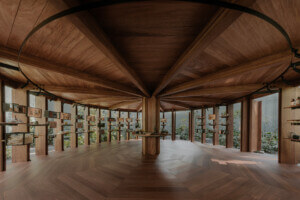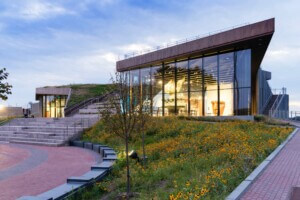Perforated steel and translucent glass balance privacy and pop.
For their Center for Manufacturing Innovation (CMI) in Monterrey, Mexico, Metalsa, a global manufacturing firm that specializes in automobile and truck chassis, did not want just another factory. Rather, the laboratory and testing facility, located in a state-sponsored research park adjacent to the Monterrey airport, was to be a “showpiece,” explained Brooks + Scarpa Architects principal Lawrence Scarpa, “not just for their clients but from a work environment point of view, and a sustainability point of view.” Despite the many challenges inherent to building across the United States-Mexico border, the Los Angeles architects succeeded in delivering a LEED Platinum design wrapped in a striking double skin of translucent glass and perforated steel panels.
The facility’s uneven sawtooth profile is the product of both historical and contextual references. “They are an industrial company, and I always loved the old warehouses with the north-facing clerestories, designed back when there was no electric lighting,” recalled Scarpa. “That was what I was thinking about before I even went to the site.” His first visit to Monterrey confirmed his instinct. “The mountains there are really sharp and jagged like that—it was an immediate concept for the building,” said Scarpa. Like their 19th-century antecedents, moreover, the clerestories provide daylight and allow hot air to accumulate high above the inhabited spaces, thus reducing reliance on artificial lighting and cooling.
The resulting form had one major drawback, however. “The issue we were faced with was that the primary way you enter the building is from the west, so we would have a broad face in the worst possible thermal position,” said Scarpa. To solve the problem of solar gain without sacrificing the sawtooth roofline, Brooks + Scarpa implemented a double skin with an outer layer composed of perforated steel panels. With a wraparound sunscreen in place, explained Scarpa, “we could have a translucent skin behind it, but could modulate light and heat gain.”
- Facade Manufacturer
Kinetica - Architects
Brooks + Scarpa, Homero Fuentes, Centro de Diseño (architect of record) - Facade Installer
Kinetica - Facade Consultants
SPID Ingenieros (engineering) - Location
Monterrey, Mexico - Date of Completion
2012 - System
perforated steel panels, translucent glass - Products
Tiger Drylac coated steel with anodized silver super polyester, fluted glass installed with 3M VHB tape and Dow Corning 795 structural silicone
Several factors influenced the perforation pattern on the outer skin. It began as an abstraction of Metalsa’s corporate identity, said Scarpa, but evolved to respond to programmatic requirements. Perforations of different sizes and densities reflect the need for more or less privacy. Areas related to proprietary research and development are more opaque, while the office spaces cantilevered over the transparent northwest entrance benefit from the additional daylighting allowed by broader perforations.
CMI’s translucent inner skin of fluted glass refracts light, preventing glare from interfering with computer-based work. To prevent the occupants from feeling trapped in a windowless box, the architects carefully modulated the distance between the envelope’s two layers. “When you’re on the interior, it doesn’t just look like a blank wall,” said Scarpa. “When you’re on the inside, you can’t see through it, but you can see shadows move on the translucent surface.”
Designing for an out-of-country client is bound to produce hiccups, and the Metalsa project was no exception. For instance, Brooks + Scarpa had initially imagined that the auto giants would fabricate the perforated metal skin in-house, but turned to another supplier when disrupting the company’s manufacturing flow proved cost-prohibitive. The architects nevertheless made the best of the situation, streamlining their vision to fit the situation at hand. “The technology that was available to us in Mexico is not overly sophisticated, so from the get-go we decided to take a more simplistic approach, utilizing a multi-layered skin,” said Scarpa. “It was easy to construct, and it’s not difficult to understand.”










